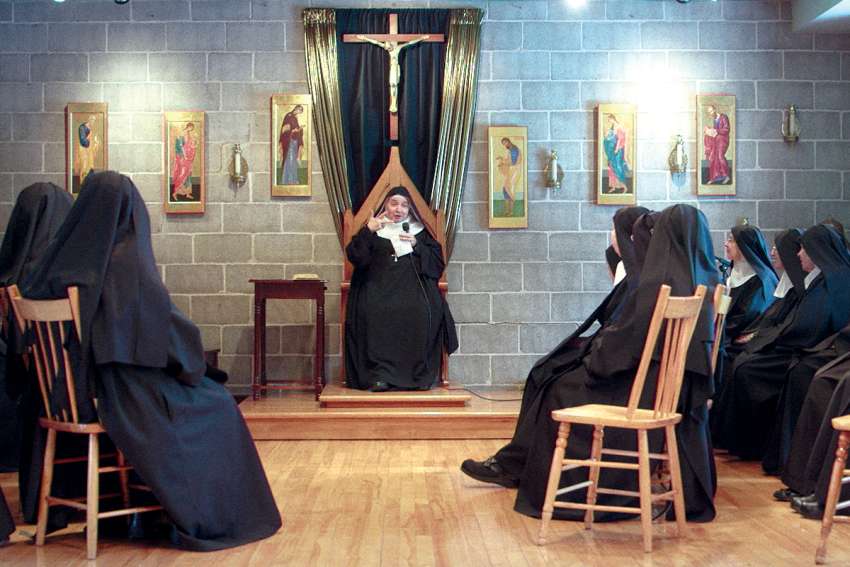The opening shot of the 2022 film shows the nuns, dressed in full wimple and habit, process two by two into the abbey church, and genuflect or bow as they turn to the altar. Sócrates chose to place the camera in the sanctuary, so that the viewer is watching the entrance of the nuns from the position of the tabernacle. Between the camera and the nuns is the grill that is both the physical and symbolic barrier between the life of the community and the outside world.
The closing scene witness the nuns trying to persuade Sócrates to join them in sledding during a winter snowstorm. Sócrates leaves the camera to the control of two of the nuns while he trudges up the hill and takes a spot on an ancient sled with another nun.
By the end of the film, Sócrates finds himself on the opposite side of the grill and the nuns are behind the camera, filming the filmmaker.
Sócrates told The Catholic Register that “this was the development of our relationship. From someone that is on the outside and arrives with a lot of, I don’t know, stereotypes. We become closer and closer, little by little, and I entered, and I got to know them.”
The idea for the project goes back over 10 years to when Sócrates was a film student at the Institut national de l’image et du son in Montreal.
For his final assignment, Sócrates wanted to focus on another artist immigrant to Canada. He settled on Russian iconographer and Montreal resident Alexandre Sobolev. Sr. Martine and Sr. Louise, two nuns from a Benedictine community outside of Montreal, were students of Sobolev and feature in the documentary short The Iconographer that Sócrates eventually produced.
“In the beginning they were more distant, and it was not an easy approach. But after a while we became friends,” said Sócrates.
Though Sócrates says he is “interested” in faith, the basis for the relationship between the filmmaker and the two nuns was a common interest in art and beauty.
“The initial connection was through art, iconography and music and aesthetic and beauty. I think it was more through this perspective of art in the beginning and after that we developed a friendship.”
After that, it was simple curiosity that inspired Sócrates’ request to film at the abbey.
“I was an immigrant, a young man, and I had been here for only two or three years. And it was an environment that was really different for me, Quebec, but also the monastery. It was a part of the process to be open to everything that is different.”
It took Sócrates some time to persuade the community to allow him to enter the abbey to film. But Sócrates says that the nuns quickly displayed an openness and curiosity that matched his own.
“They were really open to me. They didn’t ask if I had faith or if I was a Catholic. They were just open to me, to know me. And they were curious. They asked a lot about Brazil and my life there. And for me, this openness to me, the stranger, meant a lot.”
The film displays this same polite curiosity on the part of the filmmaker towards his subjects.
“I also try to be open and understand their way of life just from observing and watching it. Everybody asks, why would a woman or a man choose this kind of life nowadays? And of course I had this question, but I just chose not to ask it directly. Try to understand it alone, and I think I understand better than before.”
The bulk of the filming took place in 2014, but with no funding Sócrates let the project lie dormant. After six years, he decided to “watch everything I had shot.”
“I saw that I didn’t need to shoot more because the most interesting thing was the first period of shooting.”
It then took three or four rounds of applications for funding from the Conseil des arts et des lettres du Quebec before he had the money to move forward. The topic of a cloistered religious community didn’t make the film an easy sell in Quebec.
“I think, yes, it was trickier getting funding and I think I was able to get funding because I had shot everything with my own money, and I had just made a good 10 minutes that sold the project as a good film.”
Sócrates is pleased with the reception of the film, even though he has had to act as his own distributor.
“I’ve shown it in two good film festivals here in Montreal. I’m really happy that I was able to do it after 10 years.”
Through the eyes of “a stranger” De l’autre côte shows the “other side” of the grill.
“I don’t know if it’s because they’re from Quebec and not from France. I don’t know if that’s because they’re women and not men, but their way of life is love and friendship, it’s more important than the rules and the silence and the rigour.”


